Not the best, but then, I'm not a graphic designer.
Monday, March 31, 2014
Meme Monday: Harpo Marx's House Rules
Harpo Marx and his wife Susan Fleming adopted four children. The official house rules they came up with to run their family I thought were pretty good ones, so I tried my hand at making a Pinnable graphic out of them.
Friday, March 28, 2014
Friday Find: Craftori
Those of you visiting my blog at its homepage (instead of reading via an RSS feed) may have noticed this new badge:
I stumbled upon Craftori via a blog I just started following (Zzzonkowl). Apparently I missed it while it was still called Etsy Lush? In any case, it is everything I was expecting from CraftGawker: a place to share final, polished products and to browse other people's works—not a collection of mediocre DIY tutorials.
There's also a corresponding Etsy team, which is very explicit about only being for handcrafted or vintage (no resellers or shops with more than two owners are allowed). There is a heavy focus on promotion but there is a chat thread and a sense of camaraderie as well.
I stumbled upon Craftori via a blog I just started following (Zzzonkowl). Apparently I missed it while it was still called Etsy Lush? In any case, it is everything I was expecting from CraftGawker: a place to share final, polished products and to browse other people's works—not a collection of mediocre DIY tutorials.
There's also a corresponding Etsy team, which is very explicit about only being for handcrafted or vintage (no resellers or shops with more than two owners are allowed). There is a heavy focus on promotion but there is a chat thread and a sense of camaraderie as well.
Thursday, March 27, 2014
The Physics of Finding Flight MH370
MH370's final destination has been calculated by a British company, Inmarsat. If you're wondering exactly how they did it, PhysicsBuzz breaks it down:
How Inmarsat hacked their data to find MH370.
And you thought you'd never need trigonometry outside of high school!
I'm not one to link to the Daily Mail too often, but this write-up is mostly devoid of sensationalism and has lots of information on the disappearance and crash of MH370. Just ignore the ridiculous headline. Tl;dr: an explosion or fire on board that rendered passengers and crew alike unconscious, leaving the plane on an autopilot route to nowhere, is the most likely explanation.
How Inmarsat hacked their data to find MH370.
And you thought you'd never need trigonometry outside of high school!
I'm not one to link to the Daily Mail too often, but this write-up is mostly devoid of sensationalism and has lots of information on the disappearance and crash of MH370. Just ignore the ridiculous headline. Tl;dr: an explosion or fire on board that rendered passengers and crew alike unconscious, leaving the plane on an autopilot route to nowhere, is the most likely explanation.
Monday, March 24, 2014
Monday Meme: Books, A - Z
A. Author You've Read The Most Books From
I read a lot of Agatha Christie books in middle school. And Brian Jacques' Redwall series. Before that it was Animorphs, Nancy Drew, and The Boxcar Children. I never hopped on the Goosebumps bandwagon like so many other 90s kids did. I preferred real ("real") ghost stories, especially the ones in the collections curated by local spook hunter Charles J. Adams III.
As an adult, I am trying to get a hold of everything David Foster Wallace.
B. Best Sequel Ever
Much as I read series when I was younger, it's not a trend that continued into adulthood. The sequels I did read weren't ones that I awaited with keen anticipation; they had already been out for years by the time I read them. I guess Douglas Adams' The Restaurant at the End of the Universe?
I guess I also enjoyed Crown of Midnight even more than Throne of Glass, so there's that.
C. Currently Reading
Let's see. I've been working on Doktor Glas for a couple months now. This weekend I decided to tackle Ulysses and a short, Swedish book on women philosophers from the Middle Ages to the Enlightenment. JV is in the middle of reading Truckers to me. I also have a copy of Dead Souls on my Kindle app, as well as an oral history of slavery in America.
D. Drink of Choice While Reading
I don't really drink anything while reading. I can't do that kind of multitasking!
E. E-Reader or Physical Books
Dead tree books till I die, but I appreciate the traveling convenience of an e-reader. Not only that, but so many public domain classics are available for free!
F. Fictional Character You Would Have Dated In High School
I don't know about dated, but I would have really wanted to be friends with Holden Caulfield.
G. Glad You Gave This Book A Chance
The Sun Also Rises. I read some Hemingway in college (In Our Time) and really didn't care for him. I wasn't expecting to enjoy The Sun Also Rises at all when it came up on the TIME Top 100 list, but lo and behold it's become one of my favorites off that list.
H. Hidden Gem Book
I think a lot of the books I read for my Swedish Modernism class would qualify: Doktor Glas, Kallocain, Aniara, etc. They're really good but they never seemed to become instant hits in English, even though they all have excellent translations.
I. Important Moments of Your Reading Life
I think when I read Walden. It really ~spoke to me~ at that point in my life and I think it played a large role in shaping who I am.
J. Just Finished
Harpo Speaks!
K. Kinds of Books You Won't Read
Harlequin romance, supernatural/paranormal romance YA, most anything that's really popular. (Not trying to go for hipster points—I just usually have a different taste from what sells.)
L. Longest Book You've Read
Infinite Jest.
M. Major Book Hangover Because Of
Solaris was a strange and interesting book. I needed an extra-long time to digest it.
N. Number of Bookcases You Own:
In the states I have one floor-to-ceiling bookcase and two half bookcases. At the moment my books take up maybe half a shelf in our apartment's three Billy bookcases.
O. One Book That You Have Read Multiple Times
The Hitchhiker's Guide to the Galaxy.
P. Preferred Place to Read
On the subway, train, or bus; in waiting rooms; on the farm in Uppsala.
Q. Quote From A Book That Inspires You/Gives You Feels
There are so many! The most recent would be this anecdote from Harpo Speaks!
R. Reading Regret
A Death in the Family. The Jungle.
S. Series You Started and Need to Finish
I don't really do series. The one series I'm reading right now (Throne of Glass) hasn't been finished yet. I can only read as fast as the books come out, after all!
T. Three Of Your All-Time Favorite Books
Always such a tough question! I think I'd have to list Walden, due to its aforementioned influence on, and importance to, me when I was a young(er) person; Infinite Jest because of how massively complex and thoughtful and ponderous it is; and finally, Tacky the Penguin because we all need a little levity and cute illustrations.
U. Unapologetic Fan For
David Foster Wallace (hipsters be damned).
W. Worst Bookish Habit
If I don't have a bookmark handy, I dogear. Gasp!! I also have a tendency, when visiting people, to say hi and then drift right over their bookcase to see what they have. I also will pull out books without asking to read the back or to flip through them. That might be rude?
V. Very Excited For This Release More Than Any Other
I don't really keep track of what's coming out. The authors I like are usually dead, which makes future releases rather hard to come by. The biggest exception to this is Heir of Fire and all of the rest of the books in the Throne of Glass series.
X. Marks The Spot (Start On Your Bookshelf And Count to the 27th Book)
95% of my books are in boxes. I don't have 27 books on my shelf at the moment. :(
Y. Your Latest Book Purchase
I've been trying to pare down my book-buying recently, as our apartment doesn't have space for my habit. I think my latest may have been a replacement of Prince Caspian. I gave Lawyer Mom my copy to read and it somehow got lost in the process.
Z. ZZZ-Snatcher (last book that kept you up WAY late)
I don't read in bed, really, so this doesn't happen. I think the last time it happened was something like two years ago, with The Good Earth.
I read a lot of Agatha Christie books in middle school. And Brian Jacques' Redwall series. Before that it was Animorphs, Nancy Drew, and The Boxcar Children. I never hopped on the Goosebumps bandwagon like so many other 90s kids did. I preferred real ("real") ghost stories, especially the ones in the collections curated by local spook hunter Charles J. Adams III.
As an adult, I am trying to get a hold of everything David Foster Wallace.
B. Best Sequel Ever
Much as I read series when I was younger, it's not a trend that continued into adulthood. The sequels I did read weren't ones that I awaited with keen anticipation; they had already been out for years by the time I read them. I guess Douglas Adams' The Restaurant at the End of the Universe?
I guess I also enjoyed Crown of Midnight even more than Throne of Glass, so there's that.
C. Currently Reading
Let's see. I've been working on Doktor Glas for a couple months now. This weekend I decided to tackle Ulysses and a short, Swedish book on women philosophers from the Middle Ages to the Enlightenment. JV is in the middle of reading Truckers to me. I also have a copy of Dead Souls on my Kindle app, as well as an oral history of slavery in America.
D. Drink of Choice While Reading
I don't really drink anything while reading. I can't do that kind of multitasking!
E. E-Reader or Physical Books
Dead tree books till I die, but I appreciate the traveling convenience of an e-reader. Not only that, but so many public domain classics are available for free!
F. Fictional Character You Would Have Dated In High School
I don't know about dated, but I would have really wanted to be friends with Holden Caulfield.
G. Glad You Gave This Book A Chance
The Sun Also Rises. I read some Hemingway in college (In Our Time) and really didn't care for him. I wasn't expecting to enjoy The Sun Also Rises at all when it came up on the TIME Top 100 list, but lo and behold it's become one of my favorites off that list.
H. Hidden Gem Book
I think a lot of the books I read for my Swedish Modernism class would qualify: Doktor Glas, Kallocain, Aniara, etc. They're really good but they never seemed to become instant hits in English, even though they all have excellent translations.
I. Important Moments of Your Reading Life
I think when I read Walden. It really ~spoke to me~ at that point in my life and I think it played a large role in shaping who I am.
J. Just Finished
Harpo Speaks!
K. Kinds of Books You Won't Read
Harlequin romance, supernatural/paranormal romance YA, most anything that's really popular. (Not trying to go for hipster points—I just usually have a different taste from what sells.)
L. Longest Book You've Read
Infinite Jest.
M. Major Book Hangover Because Of
Solaris was a strange and interesting book. I needed an extra-long time to digest it.
N. Number of Bookcases You Own:
In the states I have one floor-to-ceiling bookcase and two half bookcases. At the moment my books take up maybe half a shelf in our apartment's three Billy bookcases.
O. One Book That You Have Read Multiple Times
The Hitchhiker's Guide to the Galaxy.
P. Preferred Place to Read
On the subway, train, or bus; in waiting rooms; on the farm in Uppsala.
Q. Quote From A Book That Inspires You/Gives You Feels
There are so many! The most recent would be this anecdote from Harpo Speaks!
While waiting and hoping, I went for an aimless walk in the outskirts of Indianapolis. I was depressed, and confused, and I had to be alone. I kept telling myself that something good always happened every time I hit bottom. But I didn't believe it. What could happen? What could I do? Groucho could go back in vaudeville as a single. Zeppo could go back to Chicago with Minnie, where he'd have no trouble finding a job. He was the only high-school graduate in the family. Chico could land a job as a piano player, on his own terms, anywhere.
But me? What was I trained to do besides being a Marx Brother? Well, I could play the harp on a New York City ferryboat, for nickels and dimes. Beyond that, nothing.
...
It was the only time I ever felt sorry for myself.
I came out of my daze. I was startled to find I was standing watching an auction sale. The inventory of a little general store in the suburbs—groceries, notions and dry goods—was being auctioned off. There were about twenty people there. They must have been jobbers, mostly, because the auctioneer was knocking down the stock in big lots. I was careful to keep my hands in my pockets, so I could resist any crazy impulse to make a bid, and blow my entire capital of seven cents.
The shelves were nearly emptied out and most of the crowd had left, but I still hung around, having nothing better to do with myself. Finally everything was gone except one scrub brush, the former owner, hovering in the background, the auctioneer, myself, and an elderly Italian couple. The elderly couple had been there all the time. Either they had no money or they were too timid to make a bid on anything. Whichever it was, they exchanged sad looks now that the auction was winding up.
The auctioneer was tired. "All right," he said. "Let's get it over with and not horse around. I have left here one last desirable item. One cleansing brush in A-number-one, brand-new condition, guaranteed to give you floors so clean you can eat off them. What am I offered?"
The old Italian guy and his wife looked at each other, searching for the key to the right thing to say. The auctioneer glared at them. "All right!" he yelled. "It's only a goddam scrub brush!" They held on to each other like they had done something wrong.
I said, quickly, "One cent."
The auctioneer whacked his gavel. He sighed and said, "Sold-thank-God-to-the-young-American-gentleman-for-one-cent."
I picked up my brush and handed it to the old lady. She was as touched as if I had given her the entire contents of the store. The old man grabbed my hand and pumped it. They both grinned at me and poured out a river of Italian that I couldn't understand. "Think nothing of it," I said, and added, "Ciao, eh?"—which was the only Italian I could remember from 93rd Street.
They thought this was pretty funny, the way I said it, and they walked away laughing. I walked away laughing too. A day that had started out like a nothing day, going nowhere except down, had turned into a something day, with a climax and a laugh for a finish. I couldn't explain it, but I hadn't felt so good in years. A lousy penny scrub brush had changed the whole complexion of life.
R. Reading Regret
A Death in the Family. The Jungle.
S. Series You Started and Need to Finish
I don't really do series. The one series I'm reading right now (Throne of Glass) hasn't been finished yet. I can only read as fast as the books come out, after all!
T. Three Of Your All-Time Favorite Books
Always such a tough question! I think I'd have to list Walden, due to its aforementioned influence on, and importance to, me when I was a young(er) person; Infinite Jest because of how massively complex and thoughtful and ponderous it is; and finally, Tacky the Penguin because we all need a little levity and cute illustrations.
U. Unapologetic Fan For
David Foster Wallace (hipsters be damned).
W. Worst Bookish Habit
If I don't have a bookmark handy, I dogear. Gasp!! I also have a tendency, when visiting people, to say hi and then drift right over their bookcase to see what they have. I also will pull out books without asking to read the back or to flip through them. That might be rude?
V. Very Excited For This Release More Than Any Other
I don't really keep track of what's coming out. The authors I like are usually dead, which makes future releases rather hard to come by. The biggest exception to this is Heir of Fire and all of the rest of the books in the Throne of Glass series.
X. Marks The Spot (Start On Your Bookshelf And Count to the 27th Book)
95% of my books are in boxes. I don't have 27 books on my shelf at the moment. :(
Y. Your Latest Book Purchase
I've been trying to pare down my book-buying recently, as our apartment doesn't have space for my habit. I think my latest may have been a replacement of Prince Caspian. I gave Lawyer Mom my copy to read and it somehow got lost in the process.
Z. ZZZ-Snatcher (last book that kept you up WAY late)
I don't read in bed, really, so this doesn't happen. I think the last time it happened was something like two years ago, with The Good Earth.
Friday, March 21, 2014
Friday Find: Dare2bStylish
Another great find I've stumbled on through the Etsy circles feature—and only because I went through and did a major pruning of who I was following (or had "circled" or whatever). Quantity goes down, quality goes up.
I present to you, Dare2bStylish. I love Nancy's designs SO MUCH, and even better—she carries a broad range of sizes. I wish I remember who I was following who liked one of her pieces, because I could hug them for bringing this shop to my attention. No kidding, I was just on the hunt for places to do some online shopping, I'm not much of a clothes horse or fashion fanatic (there's a reason why this isn't a fashion blog), and I don't make a sport out of clothes shopping, but I've come to have a very particular style and Nancy nails it.
I love how everything flows and drapes without looking frumpy and baggy. And—POCKETS! Pockets in the tiered trousers, pockets in the shirt dress....yes. Pockets, please! Nothing in stock goes larger than a 3X (54" waist) but it looks like she might take custom orders if you need anything larger.
I present to you, Dare2bStylish. I love Nancy's designs SO MUCH, and even better—she carries a broad range of sizes. I wish I remember who I was following who liked one of her pieces, because I could hug them for bringing this shop to my attention. No kidding, I was just on the hunt for places to do some online shopping, I'm not much of a clothes horse or fashion fanatic (there's a reason why this isn't a fashion blog), and I don't make a sport out of clothes shopping, but I've come to have a very particular style and Nancy nails it.
 |
| Gray Lagen Look Tiered Pants by Dare2bStylish on Etsy |
 |
| Travelers Lagen Look Tunic Top by Dare2bStylish on Etsy |
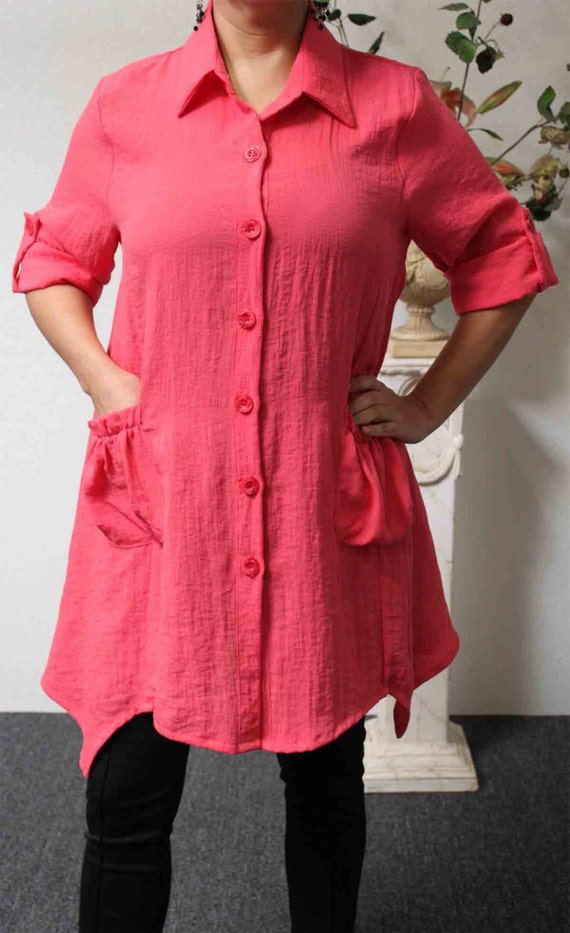 |
| Travelers Shirt With Smart Sleeves by Dare2bStylish on Etsy |
I love how everything flows and drapes without looking frumpy and baggy. And—POCKETS! Pockets in the tiered trousers, pockets in the shirt dress....yes. Pockets, please! Nothing in stock goes larger than a 3X (54" waist) but it looks like she might take custom orders if you need anything larger.
Wednesday, March 19, 2014
Astronomy and Public Art
Today I learned that the largest to-scale model of the solar system in the world is here in Sweden: the Sweden Solar System. A very dull name for a very creative project.
The Sweden Solar System isn't something in a museum, or a park. It spans the nearly the entire country, and includes comets, dwarf planets, and other night sky wanderers, in addition to the usual planets:
The Sweden Solar System is the brainchild of physicist Nils Brenning and astronomer Gösta Gahm. Numerous artists have contributed to the project. Here is a rundown of all the current members of the Sweden Solar System, if you want to read more about them (in English). I love the level to which the artists and others involved committed themselves to "properly" representing the planet. Mercury, for example, is heated, a nod to its high temperature (second-highest of all the planets) and proximity to the sun.
I think I might make it a goal to visit all of the planets—this should come as no surprise if you've been following along for any stretch of time. My love of astronomy is pretty self-evident.
The Sweden Solar System isn't something in a museum, or a park. It spans the nearly the entire country, and includes comets, dwarf planets, and other night sky wanderers, in addition to the usual planets:
 |
| I live within walking distance of the sun. |
The Sweden Solar System is the brainchild of physicist Nils Brenning and astronomer Gösta Gahm. Numerous artists have contributed to the project. Here is a rundown of all the current members of the Sweden Solar System, if you want to read more about them (in English). I love the level to which the artists and others involved committed themselves to "properly" representing the planet. Mercury, for example, is heated, a nod to its high temperature (second-highest of all the planets) and proximity to the sun.
I think I might make it a goal to visit all of the planets—this should come as no surprise if you've been following along for any stretch of time. My love of astronomy is pretty self-evident.
Sunday, March 16, 2014
101 in 1001: Doktor Glas
I've revamped how I'm doing the 101 in 1001 updates here. While it's helpful for me to be able to see and edit the list every time I update, a lot of RSS readers don't observe Blogger's "jump" feature and so who knows how many people I've inadvertently spammed with my weekly numerations of all of the things I wanted to accomplish with my life! My 101 in 1001 list now has its own permanent page, and updates from now on will contain only tasks that I've accomplished.
Read 3 chapters of Doktor Glas in Swedish. (1 - 7)
I first encountered Doktor Glas in a course I took at Stockholms Universitet (in English) on Modern Swedish Literature. It was by far my favorite book of the course, and not just because it was the shortest. Since I liked it so much, I thought it would be a good introductory course to literary Swedish. While a lot of the vocabulary is a bit outdated and old-fashioned, it's still been a rewarding project. Perhaps I'll shoot for five chapters as a new goal in my next review.
Doktor Glas is the (obviously fictional) diary of Tyko Gabriel Glas, a young doctor in Stockholm at the turn of the last century. He writes extensive chronicles of his thoughts on medicine, euthanasia, sex, murder, love, abortion, punishment, and of his involvement in the unhappy marriage of young Helga to the odious minister Gregorious. Quite a lot for a slim little volume, and easy to end up sounding heavy-handed and preachy, but Söderberg keeps a deft, masterful touch over the whole thing. I cannot emphasize that enough: Doktor Glas is a literary masterpiece. Alas that it doesn't enjoy the same international celebration as Beyond Good and Evil or Crime and Punishment; life is truly unfair.
If you're interested in it, I highly recommend the translation by Paul Britten Austin. I don't know if other translations of this novel exist, but if they do, I'm not interested in them. Austin's translation is poetic and graceful and suffers none of the clunk and clumsy of a bad translation; I doubt it's possible to find anything better.
Read 3 chapters of Doktor Glas in Swedish. (1 - 7)
I first encountered Doktor Glas in a course I took at Stockholms Universitet (in English) on Modern Swedish Literature. It was by far my favorite book of the course, and not just because it was the shortest. Since I liked it so much, I thought it would be a good introductory course to literary Swedish. While a lot of the vocabulary is a bit outdated and old-fashioned, it's still been a rewarding project. Perhaps I'll shoot for five chapters as a new goal in my next review.
Doktor Glas is the (obviously fictional) diary of Tyko Gabriel Glas, a young doctor in Stockholm at the turn of the last century. He writes extensive chronicles of his thoughts on medicine, euthanasia, sex, murder, love, abortion, punishment, and of his involvement in the unhappy marriage of young Helga to the odious minister Gregorious. Quite a lot for a slim little volume, and easy to end up sounding heavy-handed and preachy, but Söderberg keeps a deft, masterful touch over the whole thing. I cannot emphasize that enough: Doktor Glas is a literary masterpiece. Alas that it doesn't enjoy the same international celebration as Beyond Good and Evil or Crime and Punishment; life is truly unfair.
If you're interested in it, I highly recommend the translation by Paul Britten Austin. I don't know if other translations of this novel exist, but if they do, I'm not interested in them. Austin's translation is poetic and graceful and suffers none of the clunk and clumsy of a bad translation; I doubt it's possible to find anything better.
Friday, March 14, 2014
Happy Pi Day!
It's that time of year again! And time for my annual Pi Day roundup.
It's still a little chilly here in Sweden, so a winter hat like this chullo is perfectly acceptable headgear. I appreciate that Ehmeelu has hats that are extra large, too: people with big heads still get cold! JV has always had a massive head and the only winter hat he's ever had that fits is one that Lawyer Mom crocheted specifically for him. Please, craftsters, do like Ehmeelu and think of all the big-headed people in the world who can't find a good winter hat.
I've never been much of a scrapbooker, but I have been tracking other people's obsession with washi tape and am amazed with the things they do with it and the myriad of patterns and designs available. This is the perfect item for anyone interested in arts and maths. Or maybe I should snatch it up to use in my packaging...!
This is exactly how I feel about JV. Together, we're like pi: he's my constant and I'm irrational.
Normally the asymmetry of the design would bother me, but in this case I rather like it! This is the kind of nerd shirt you could totally dress up for a formal event and no one would have to be the wiser. Bonus points for matching it with some fancy pi bling.
 |
| Cherry Pi Chullo for Big Heads by Ehmeelu |
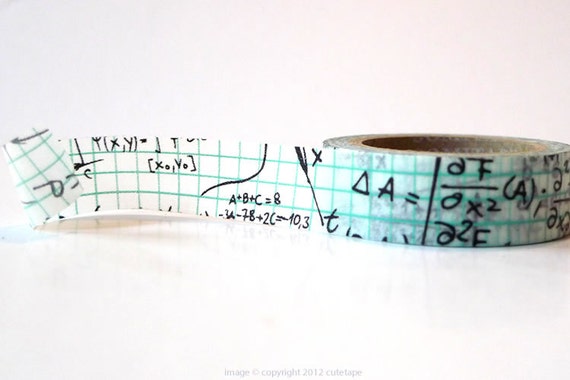 |
| Grid Math Washi Tape from PrettyTape |
I've never been much of a scrapbooker, but I have been tracking other people's obsession with washi tape and am amazed with the things they do with it and the myriad of patterns and designs available. This is the perfect item for anyone interested in arts and maths. Or maybe I should snatch it up to use in my packaging...!
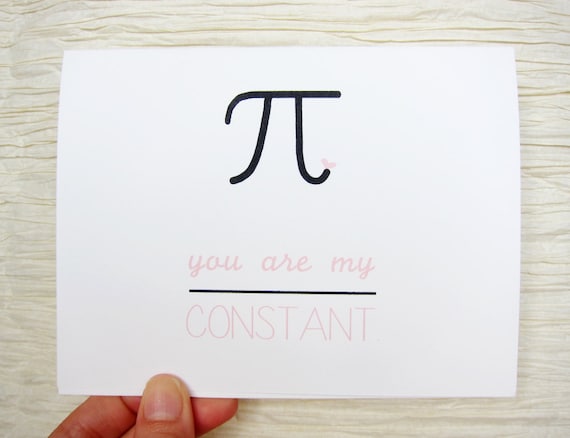 |
| "You Are My Constant" Card by witsicle. |
This is exactly how I feel about JV. Together, we're like pi: he's my constant and I'm irrational.
 |
| Pi Long-Sleeved Shirt by fqcouture |
Labels:
apparel,
fiber,
math,
papercraft,
supplies
Wednesday, March 12, 2014
Birthstones: Diamond (April)
She who from April dates her years,No gemstone is more iconic of wealth and luxury in our culture than diamonds. They are, after all, a girl's best friend.
Diamonds shall wear, lest bitter tears
For vain repentance flow; this stone,
Emblem of innocence, is known.
 |
| Square cut or pear-shaped, these rocks won't lose their shape. |
On a molecular level, diamonds are giant lumps of pure carbon: no oxygen, no silicon, no iron, just carbon. Heat and pressure (more pressure than heat) turned them from dull, black stuff into the clear, sparkling gems we know and love today.
 |
| These are made from exactly the same stuff. |
The name comes from the Greek word adámas, meaning "unconquerable" or "unbreakable," in reference to their hardness. This unbreakable quality is why diamond has so many industrial uses: drilling, carving, as grit, and so on, and was immediately apparent to the people who found them. Diamond's use as an engraving tool has been dated to approximately 500 BCE in India, though the Chinese may have been using them earlier.
Their rigid lattice prevents most of the kinds of impurities that lend other gems their color, but there are always notable exceptions. Trace amounts of boron or nitrogen can color a diamond blue or yellow, respectively. Flaws in the structure of the lattice result in a brown, pink, or red hue (depending), and radiation can turn them green.
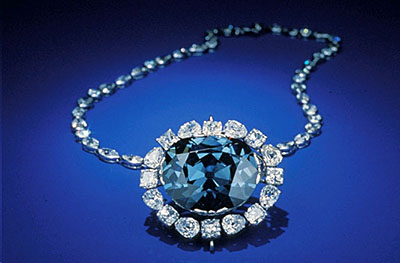 |
| The Hope Diamond owes its distinctive blue color to trace amounts of boron. |
Because of the conditions of their formation, diamonds aren't a mineral that just hangs around the Earth's surface, waiting to be discovered. Typically they form deep beneath the surface, beyond continental plates, and thus need to be sucked out of the ground through a volcanic eruption or mine, though some are created in meteorite impacts. The first diamonds to fall into human hands were probably picked up out of alluvial (i.e. riverbed) deposits in India anywhere from 3,000 to 6,000 years ago.
In addition to being used for engraving and stone cutting, the lovelier ones were used in jewelry and religious garb. According to Vedic astrology, diamonds are associated with Venus and enhance wealth, fame, and fertility. The Greeks believed they were pieces of stars or tears of the gods (depending on who you were talking to). In the early Middle Ages in Europe, diamonds were thought to possess incredible medicinal powers, though by the late Middle Ages, this belief had faded into obscurity and the gems were prized primarily and chiefly for their economic value.
Truth be told I have always found diamonds pretty boring as far as decoration goes. The biggest allure that rocks and minerals have for me is their stunning array of colors, and aside its unusually high refractive index and the odd "flawed" specimen, color is something diamonds just don't have. Beyond that, I've seen the same beautiful light play and clarity you expect from a diamond in a properly cut quartz—those are characteristics by no means unique to diamonds.
In addition to being used for engraving and stone cutting, the lovelier ones were used in jewelry and religious garb. According to Vedic astrology, diamonds are associated with Venus and enhance wealth, fame, and fertility. The Greeks believed they were pieces of stars or tears of the gods (depending on who you were talking to). In the early Middle Ages in Europe, diamonds were thought to possess incredible medicinal powers, though by the late Middle Ages, this belief had faded into obscurity and the gems were prized primarily and chiefly for their economic value.
Truth be told I have always found diamonds pretty boring as far as decoration goes. The biggest allure that rocks and minerals have for me is their stunning array of colors, and aside its unusually high refractive index and the odd "flawed" specimen, color is something diamonds just don't have. Beyond that, I've seen the same beautiful light play and clarity you expect from a diamond in a properly cut quartz—those are characteristics by no means unique to diamonds.
Oddly enough, people seem to disagree with me on that point. (Go figure!) Diamonds are still highly valued commodities, and even today there is a byzantine, deadly market that revolves around them. For more information about those markets and diamonds in general:
'Delightful Diamonds' by Kokoba
Sponsored by send bulk email from excel.
Tuesday, March 11, 2014
Language Acquisition and Cosmos
Today is the first day of my 20 hour/week Swedish course. It's not the same kind of demand as a full-time job, obviously, but it does mean I won't have as much time or focus for blog entries as I've recently had. I have a few posts queued up, so even if I get swamped with work I won't disappear entirely. At least, not right away.
More importantly, JV and I watched the first installment in the Cosmos reboot and we were blown away. I've never been a fan of Seth MacFarlane, both as a humorist and as a person, but I am appreciative of the work he, Neil DeGrasse Tyson, and others put into making the new Cosmos happen. If you missed the first episode, you can catch up at CosmosOnTV.com. If you're outside the US, I highly recommend the Hola plugin to mitigate any location-related difficulties.
More importantly, JV and I watched the first installment in the Cosmos reboot and we were blown away. I've never been a fan of Seth MacFarlane, both as a humorist and as a person, but I am appreciative of the work he, Neil DeGrasse Tyson, and others put into making the new Cosmos happen. If you missed the first episode, you can catch up at CosmosOnTV.com. If you're outside the US, I highly recommend the Hola plugin to mitigate any location-related difficulties.
Saturday, March 8, 2014
Science Saturday: International Women's Day
March is Women's History Month; March 8th is celebrated around the globe as International Women's Day. Granted, some countries are more interested in observing it than others. What an opportunity, then, to highlight some of the overlooked and unsung heroines in STEM on this Science Saturday!
Perhaps one of the biggest things that keep women (and I mean women systemically, as a whole; individual women have individual experiences that deviate from the norm in all kinds of ways) out of STEM fields is the "you can't be what you can't see" phenomenon. After hundreds of years men doing most of the heavy academic lifting because women were rarely given a chance, a vicious cycle was set up: men were given a head start, made a good portion of the significant breakthrough in the early years of "science" (after the painful separation from its conjoined twin, "natural philosophy"), and so it was that science became a de facto masculine set of fields with male pioneers. We can't know how many female Lavoisiers or Copernicuses or Galileos there could have been had they been given equal education and access to the same resources.
Even when women were finally given access to the same education, habit or prejudice or a combination of the two often resulted in their discoveries and contributions being minimized or ascribed to male colleagues. This erasure has finally begun to be addressed, and the result is that every day there seems to be a new STEM innovator whose share of the spotlight would no doubt had been greater if she had been born a man. Scientific American has a great collection of art depicting a few of these interesting and brilliant women; I encourage you to click through and browse the entire collection. (It includes a print from the Mad Scientists of Etsy's own resident marine geophysicist artist and new mom, minouette!)
STEM fields are ever improving their gender equity, over the long run. Disparities remain in many fields, but they are being addressed and treated as the serious issues they are. The CataLyst series over on STEMinist.com has just begun to look at these issues and the many underlying reasons, so make sure to keep an eye on that corner of the web for studies and commentary on the topic. And while the Wikipedia Women in Science Edit-a-thon is over, the work is far from done. Anyone concerned about the representation of women in science should register as an editor and contribute to articles on women scientists or even write new ones. Finally, make it a point to actively seek out, celebrate, and learn about the women in science of today and yesterday. Share stories and images on social media to signal boost their accomplishments and to normalize images of women in the sciences. Here are just a few to get started:
Ify Aniebo is getting her PhD in medicine from Oxford, conducted HIV/AIDS research in Swaziland, and one day hopes to cure malaria.
Ruby Hirose made significant contributions to the polio vaccine.
Rosalyn Sussman Yalow won a Nobel Prize for developing the radioimmunoassay technique, which dramatically improved allergy tests.
Barbara McClintock also won a Nobel Prize for her work in genetics; specifically, the idea of genetic recombination in maize.
Who are your favorite women in science?
Perhaps one of the biggest things that keep women (and I mean women systemically, as a whole; individual women have individual experiences that deviate from the norm in all kinds of ways) out of STEM fields is the "you can't be what you can't see" phenomenon. After hundreds of years men doing most of the heavy academic lifting because women were rarely given a chance, a vicious cycle was set up: men were given a head start, made a good portion of the significant breakthrough in the early years of "science" (after the painful separation from its conjoined twin, "natural philosophy"), and so it was that science became a de facto masculine set of fields with male pioneers. We can't know how many female Lavoisiers or Copernicuses or Galileos there could have been had they been given equal education and access to the same resources.
Even when women were finally given access to the same education, habit or prejudice or a combination of the two often resulted in their discoveries and contributions being minimized or ascribed to male colleagues. This erasure has finally begun to be addressed, and the result is that every day there seems to be a new STEM innovator whose share of the spotlight would no doubt had been greater if she had been born a man. Scientific American has a great collection of art depicting a few of these interesting and brilliant women; I encourage you to click through and browse the entire collection. (It includes a print from the Mad Scientists of Etsy's own resident marine geophysicist artist and new mom, minouette!)
 |
| Inge Lehmann linocut by minouette |
Ify Aniebo is getting her PhD in medicine from Oxford, conducted HIV/AIDS research in Swaziland, and one day hopes to cure malaria.
Ruby Hirose made significant contributions to the polio vaccine.
Rosalyn Sussman Yalow won a Nobel Prize for developing the radioimmunoassay technique, which dramatically improved allergy tests.
Barbara McClintock also won a Nobel Prize for her work in genetics; specifically, the idea of genetic recombination in maize.
Who are your favorite women in science?
Friday, March 7, 2014
Friday Find: Pinterest Edition
You can always follow me (click that button on the right!), of course, and never miss a single thing I pin ever, but some finds are worth sharing elsewhere! For example, this awesome print from Not On the High Street, showing all of the planets in the solar system to scale:
And finally, a handy and humorous flowchart to help you figure out what you're looking at in the night sky.
Continuing the astronomy theme, here's a great photoset from Imgur of a shawl decorated with the constellations of the Northern Hemisphere. I don't know who you are or where you got this, jeffp07, but it's gorgeous:
And finally, a handy and humorous flowchart to help you figure out what you're looking at in the night sky.
Tuesday, March 4, 2014
Fat Tuesday and Pea Soup
I had totally forgotten today was Fat Tuesday until I asked Google when it was this year. Timing!
Where I grew up in the US, Fat Tuesday is observed by the consumption of donuts, or the not-as-sweet fastnachts if you're traditional.
Where I grew up in the US, Fat Tuesday is observed by the consumption of donuts, or the not-as-sweet fastnachts if you're traditional.
The Swedish tradition (Fett Tisdag) uses the particularly Swedish semlor, which are massive cream-filled, sightly spicy (Wikipedia says it's cardamom) pastries.
The idea behind every Fat Tuesday tradition is to load up on as much delicious food as you can before the restrictive fasting of Lent, and that's the same idea with the above semlor. But there's another pre-fasting food tradition in Sweden I didn't learn about until recently.
In the days of yore, after Christianity finally spread to Sweden (it took longer here than in the rest of Europe), Friday was established as a Catholic day of fasting. Thursday, then, was a day to eat as much and as nicely as you could, and for many peasants pea soup (with pork) was a rich, welcome change from the usual turnips and kale. Today, even though Sweden leads the world in atheism, the tradition remains. Pea soup is still a popular dish on Thursdays in Sweden, served in schools, restaurants, and army mess halls.
We don't have pea soup every Thursday ourselves (JV didn't know it was a thing until I found out about it), preferring Pizza Friday and (to a lesser extent) Candy Saturday, but there is usually a tube of ready-made pea soup in the fridge for when we don't feel like cooking. We usually have some bread and cheese to go with it; the soup is so thick that we can just spread it on top of the bread.
We'll be enjoying our semlor today, even though we're not giving up any fatty food for Lent. JV also made some delicious chocolate mousse with tofu and banana. Not quite as traditional but still just as tasty!
Monday, March 3, 2014
Music Monday: Animals And Music
Stumbled across this article on InsideScience.og: Can animals keep a beat?
The teal deer for the link-phobic: not really, it seems. Scientists theorize that for humans, music began out of socialization processes. Humans start to synchronize themselves with a rhythm at about age 4, as they learn to mimic and interact with others. Music as socialization (different from the birdcalls and whale songs on "sounds of nature" CDs) appears to be something uniquely human, though sea lions and bonobos seem to have the hang of it:
A really interesting book on the topic (which warrants a re-reading on my behalf; it's been quite a few years) is Daniel Levitin's This Is Your Brain on Music. Long story short: music (of all genres) is an activity that engages multiple parts of our wrinkly, complicated brains simultaneously and in many fascinating ways.
The teal deer for the link-phobic: not really, it seems. Scientists theorize that for humans, music began out of socialization processes. Humans start to synchronize themselves with a rhythm at about age 4, as they learn to mimic and interact with others. Music as socialization (different from the birdcalls and whale songs on "sounds of nature" CDs) appears to be something uniquely human, though sea lions and bonobos seem to have the hang of it:
A really interesting book on the topic (which warrants a re-reading on my behalf; it's been quite a few years) is Daniel Levitin's This Is Your Brain on Music. Long story short: music (of all genres) is an activity that engages multiple parts of our wrinkly, complicated brains simultaneously and in many fascinating ways.
Saturday, March 1, 2014
Science Saturday: The 5 Most Gorgeous, Dramatic Pleochroic Gems
First of all, what is pleochroism?
The word comes from the Greek word pleo, meaning "more," and chroma, meaning "colors." More colors: right what it says on the tin. Pleochroism is the neat trick some minerals do where their color changes depending on the light and the angle you look at them. It can vary from slight changes in the saturation (from dark to light and vice versa) or it can be extreme changes in the the hue itself (from one color to another).
Pretty cool, right? So how does it work?
It comes down to light. (Which, for our purposes, is a wave.) Light waves oscillate, but they oscillate along multiple axes. As you change the angle of these minerals, you change which particular axis of oscillation hits the crystal structure, which changes the color you see. This is different from iridescence and schiller, which is a result of light reflection.
Remember, it's not as though anything about the stone's physical existence is changing as you rotate it; it's a change in the character of the light. (Since you don't see "things" as much as you see "light bouncing off of things.")
The effect is more striking in polarized light, in which the waves oscillate along the same axis. Those are what polarized lenses (like for cameras, or in certain sunglasses) do. They're not just tinted; they have a chemical coating that blocks out all but one of the planes of oscillation. The result is a drastic reduction in glare and richer, less washed-out colors.
Many gems exhibit some level of pleochroism, but the ones here are the most dramatic and (in my opinion) the loveliest. You should be able to see the color change in plain old unpolarized light in any of these—just change the angle you're viewing it at.
1. Iolite (Cordierite)
The word comes from the Greek word pleo, meaning "more," and chroma, meaning "colors." More colors: right what it says on the tin. Pleochroism is the neat trick some minerals do where their color changes depending on the light and the angle you look at them. It can vary from slight changes in the saturation (from dark to light and vice versa) or it can be extreme changes in the the hue itself (from one color to another).
Pretty cool, right? So how does it work?
It comes down to light. (Which, for our purposes, is a wave.) Light waves oscillate, but they oscillate along multiple axes. As you change the angle of these minerals, you change which particular axis of oscillation hits the crystal structure, which changes the color you see. This is different from iridescence and schiller, which is a result of light reflection.
Remember, it's not as though anything about the stone's physical existence is changing as you rotate it; it's a change in the character of the light. (Since you don't see "things" as much as you see "light bouncing off of things.")
The effect is more striking in polarized light, in which the waves oscillate along the same axis. Those are what polarized lenses (like for cameras, or in certain sunglasses) do. They're not just tinted; they have a chemical coating that blocks out all but one of the planes of oscillation. The result is a drastic reduction in glare and richer, less washed-out colors.
Many gems exhibit some level of pleochroism, but the ones here are the most dramatic and (in my opinion) the loveliest. You should be able to see the color change in plain old unpolarized light in any of these—just change the angle you're viewing it at.
1. Iolite (Cordierite)
 |
| Iolite, courtesy Wikipedia |
(Mg,Fe)2Al4Si5O18
Color range: from deep blue/purple to almost clear.
I came to know this stone by the name of iolite, from the Greek word for "violet," but it's also known as cordierite, after the geologist Louis Cordier. Aside from its use in ornamentation, iolite (a synthetic version) is also used in catalytic converters to keep the ceramic from cracking due to heat.
2. Kunzite (pink spodumene)
| Kunzite, courtesy GIA.edu |
LiAl(SiO3)2
Color range: pink/light purple to clear.
Kunzite is named after mineralogist legend G. F. Kunz, who was the first to discover it. While he initially found it in the United States, kunzite is mined all over the world. The pink comes from traces of manganese (also found in rhodonite). Spodumene is an important source for lithium, which we use in rechargeable batteries and in some medications.
There is a green-to-clear variation of spodumene, called hiddenite, which is also pleochroic.
3. Kyanite
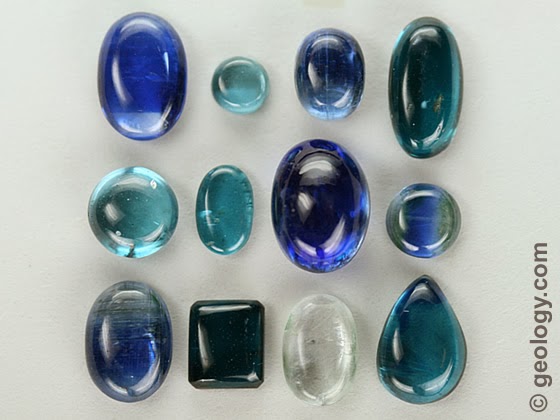 |
| Kyanite, courtesy geology.com |
Al2SiO5
Color range: from dark, royal blue to sky blue to clear.
Not only is kyanite pleochroic, it's also anisotropic. That means it exhibits two levels of hardness perpendicular to each other, a trait very useful for its identification. Kyanite is often used in ceramics, particularly in dishware and in plumbing. The name derives from the Greek word kyanos, meaning "light blue".
Kyanite is a polymorph of andalusite and sillimanite, which are both pleochroic as well. Andalusite ranges from golden yellow to olive green, while sillimanite is clear to a light yellow-brown. In addition to being cut and used in jewelry, all three polymorphs are useful to geologists when trying to determine the heat-pressure history of larger host rocks.
4. Sphene (titanite)
 |
| Sphene (titanite), courtesy gemsociety.org |
CaTiSiO5
Color range: from reddish-brown to olive green to yellow.
Originally called sphene (from the Greek sphenos, meaning "wedge," in reference to its wedge-shaped crystal habit), the International Mineralogical Association "officially" changed it to titanite (due to its titanium content) in 1982. Books, collectors, and jewelers know it by both names. In addition to being cut and used in jewelry, titanite is also a source of titanium dioxide (TiO2), commonly used in white pigments and sunscreen because of its refractive abilities.
5. Tanzanite
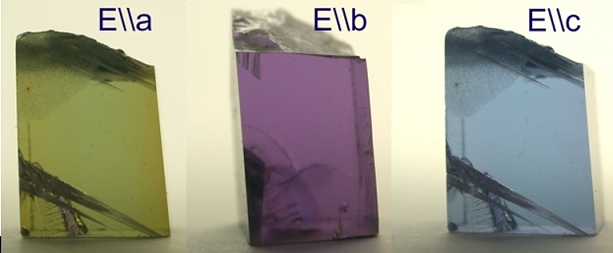 |
| Tanzanite, courtesy CalTech.edu |
Ca2Al3(SiO4)(Si2O7)O(OH)
Color range: from purple to blue to yellow-brown.
Tanzanite is named for Tanzania, the single source on Earth for this blue-purple variety of zoisite. The scientific name is actually blue zoisite, but Tiffany & Co. led the charge to call it tanzanite. They felt "blue zoisite" wasn't a very marketable name (it sounds like "blue suicide") and thought they'd capitalize on the gem's unique source. Tanzanite is not typically used outside of ornamentation and jewelry. However, it has proven to be so popular that it was added as an "official" birthstone for December; you may recognize its name from the updated Kansas jewelers' list. It should also be noted that commercial tanzanite is always heated to remove the yellow-brown coloration, so jewelry and cut stones only exhibit the purple-blue pleochroism.
Sometimes these gems are cut and set to show off their brilliant pleochroism and multitude of brilliant colors. Other times, cutters and jewelers try to minimize the effect as much as possible. Pleochroism occurs in many more minerals and gems than listed here—it's a trait often used in identifying minerals—but the effect is much more striking in some stones than in others.
Which one do you like the best?
Subscribe to:
Posts (Atom)







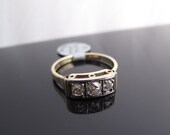

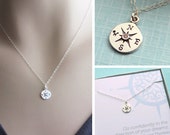
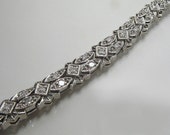
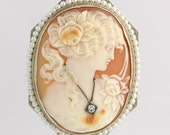
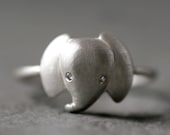
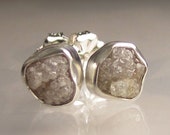
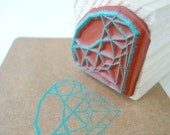
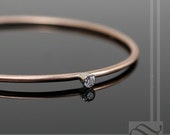
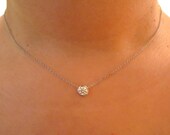
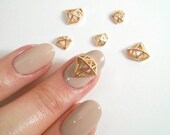
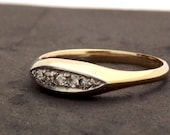
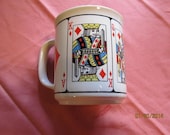
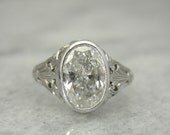
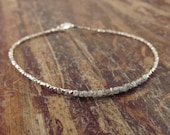
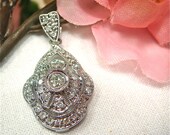
.jpg)

